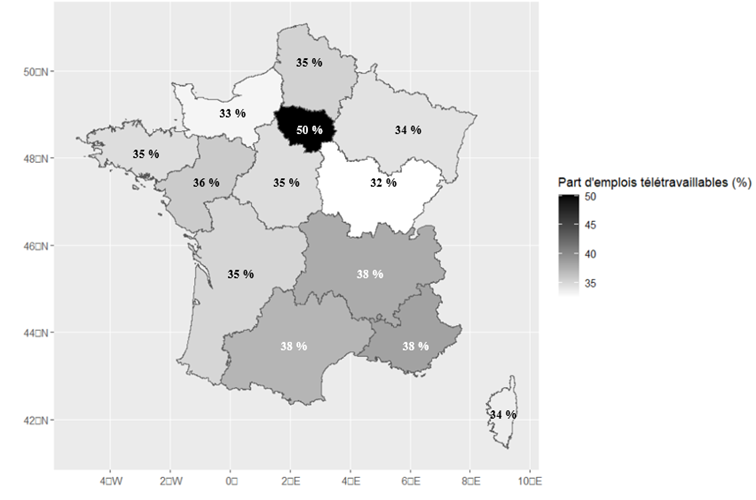- Home
- EN
- Our impact
- ProspeKtive
- Teleworking: a revolution or a revelation of major real estate trends?

Teleworking: a revolution or a revelation of major real estate trends?
March 2024
Expert
Since the first confinement, the real estate world has been wondering about the so-called new places where French households live and work. Local councillors and developers alike saw an opportunity to rebalance the French territory, historically centralized around Paris. Yet initial post-covid trends do not point to a new world. What if the pandemic was merely a revelation rather than a revolution in the major territorial dynamics of the residential and office markets? Is telecommuting a real game-changer for France?
Telecommuting is neither new, nor close to democratization, nor ready to disappear.
Legislated by the French government in 2012, the practice of telecommuting is in fact part of a more profound transformation of office activities. Pascal Picq sees the pandemic as "an exogenous shock in an endogenous process". For the time being, however, its democratization is quite simply impossible: according to INSEE, only the Île-de-France region has a 50% share of jobs that can be teleworked. So telecommuting is not for the majority of workers. In addition, company management practices, size, sector, employee preferences and legislation are all criteria to be considered.
Regional mapping of teleworkable jobs

Source: Mathieu Obertelli based on Insee data
What's more, the practice has been declining since the first confinement. According to DARES, the proportion of teleworkers who telework at least once a week fell from 40% to 24% between March 2020 and December 2021. Nevertheless, the disappearance of telecommuting is hardly credible, given that its practice is an advantage often reserved for executives. According to Obsoco, over 50% of managers in France claim to telework at least once a week, compared with 15% of employees. Telecommuting therefore remains an argument for recruiting skilled workers, who are strongly attached to it.
Telecommuting does not mean urban exodus
It's still common to hear on the radio, see on television or read on social networks that the pandemic has driven city dwellers out of the big cities and into the countryside. However, the various studies carried out by POPSU researchers show that this phenomenon is marginal, as the bulk of flows take place between cities: people leave a very large city for a smaller one, as long as the latter meets the essential needs of an urban dweller. In fact, the most frequent case is to leave a large city to move to its outskirts, where residences are larger and less expensive. This is a classic phenomenon of "peri-urbanization", and metropolises are particularly affected by it.
Instead, the pandemic has shed light on a phenomenon that has been largely obscured until now: as demonstrated by Bouba-Olga and Grossetti (2018) not all metropolises are necessarily attractive, and attractive communes are not necessarily metropolises. According to Insee data, looking back over the last 50 years, 11 out of 22 metropolises have seen more residents leave than arrive within them. The metropolis that has lost the most inhabitants is...Paris! Moreover, it's misleading to think in terms of "city size" rather than regional area. Communes in the north-eastern quarter of France are still finding it hard to attract residents, while those in the south and west of France are taking advantage of their coastline to do so.
Centrality still central to office location strategies
Telecommuting is part of a policy of flex-office, i.e. sharing workstations, with a view to optimizing the surface area rented by companies, which represents their second-largest item of expenditure after salaries. The reduction in the surface area rented by companies leads them to relocate to a more accessible position with more amenities, in a bid to recruit and attract new workers.
The Paris region is a good illustration of this phenomenon. In a region that has seen demand for leased m² fall by 17.5% by 2023, the QCA is in insolent form. It has never had such a low vacancy rate (less than 3%) and such high rents (1000 EUR/m²/year prime). The opposite is true for the eastern suburbs, where rents are falling and vacancy will soar to over 20% in Saint-Denis by the 3rd quarter of 2023, according to Immostat.
In short, telecommuting is not a widespread phenomenon. While it has accelerated the departure of some residents, particularly in the capital, this trend is far from new. It is also misleading to conclude that the French territory has been rebalanced. If we look at companies' location strategies, they have never been so keen on centrality in the Paris region... So there's nothing new under the sun.
Bibliography
- OBSOCO, IDHEAL, ACTION LOGEMENT (2023) : L’observatoire du télétravail. Au bureau sans bureau.
- Bouba-Olga, O. & Grossetti, M. (2018.). La mythologie CAME (Compétitivité, Attractivité, Métropolisation, Excellence) : comment s’en désintoxiquer ? HAL
- Picq, P. (2020). Les chimpanzés et le télétravail. Edition Eyrolles.
- PUCA-POPSU (2022)., Exode urbain : impacts de la pandémie de COVID-19 sur les mobilités résidentielles », Le Réseau Rural Français et le Plan Urbanisme Construction Architecture. 2022.
- Sostero M., Milasi S., Hurley J., Fernández-Macías E., Bisello M., Teleworkability and the COVID-19 crisis: a new digital divide?, Seville: European Commission, 2020, JRC121193.
Release date: March 2024



